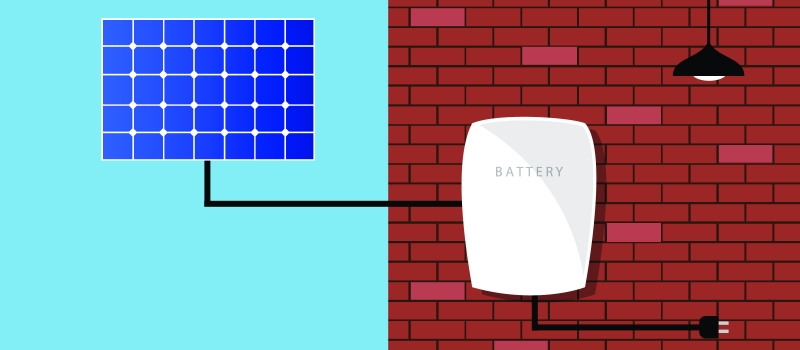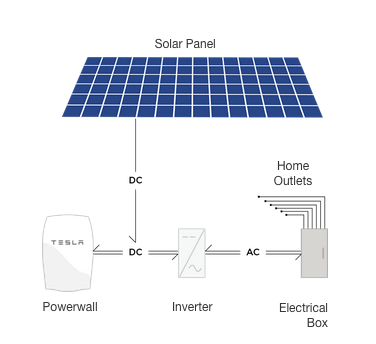Solar to the People – Helping you get the best price on solar
Solar Batteries
Discover how much you can save today with our solar calculator
Solar batteries store electricity, but can they save money?

So long as the sun’s out, your solar panels generate electricity. The problem with how solar power works is that you’re not always home to consume it when it’s produced. Depending on how many solar panels to run a house, you may also be routinely producing more energy than you need at any given time. While you can return excess electricity back to the grid in exchange for a deduction in your utilities if you’re plugged into the grid, the value of your electricity during these off-peak hours, when most families are away from the home, is often less than during peak hours. A solar battery allows you to store unused energy and then consume it when energy is most expensive.
To learn more about electricity pricing in your area and the net benefit of solar power, check out our solar calculator!
However, solar batteries have so far failed to provide a financial benefit to customers who can net meter—the term for selling back power to the grid, usually in exchange for a deduction on your utility. This is especially true where utilities don’t adjust electricity rates based on time of use (TOU). In these cases, power sold back to the grid and power pulled from a battery will have the same value, at any time of day. Where utilities do adjust rates according to TOU, the electricity stored in a battery during off-peak daytime hours will offer additional savings during peak hours. Over time, using battery power when grid power is most expensive could in theory offset the upfront cost of a battery.
In practice, the actual cost of kWh from solar batteries have failed to offset the high upfront cost of the battery. However, reductions in cost to lithium-ion batteries and advances in energy battery energy management might finally make batteries a sound investment for houses able to connect to the grid.
Tesla Powerwall
With the March 2016 release of Powerwall 2.0, Tesla significantly improved its home battery option by doubling capacity from 7 to 14 kilowatt-hours and incorporating a power inverter. Tesla also flattened the battery to a slender 6.1 inches and squared the old model’s rounded edges, allowing the batteries to stack and to fit more easily on inconspicuous wall space or be installed freestanding.
Tesla Powerwall

The original Powerwall, and now Powerwall 2.0, are Tesla’s first entries into the home battery market. The Powerwall is the highly functional, if less flashy part of Tesla’s broader solar strategy, which centers on its Solar Roof line of natural-looking solar panels.
Given that the US Energy Information Administration estimates the average American household consumes 30 kWh per day, a single Powerwall 2.0 battery can provide for half of a home’s daily consumption. However, there are two caveats: your PV system must produce that much excess power for the battery to be any use, and depending on the energy use habits of your household you might consume significantly more or less power during the peak hours when you’re most likely to use a battery. Tesla has accounted for the latter case, redesigning the Powerwall 2.0 to be slimmer and easily stacked with additional batteries.
The inclusion of an inverter does raise the overall cost of the Powerwall. However, this decision should benefit most customers. Inverters convert power generated by solar panels from direct to the alternating current (DC to AC) used by home electronics, and so are a required in every solar battery setup. A third-party inverter means the second box of electronics mounted to the wall and possible compatibility issues, especially in international markets. Worse, you’re unlikely to save on a standalone inverter, which starts around $1,000. According to Greentech Media, Tesla was able to undercut inverter manufacturers by bringing over cheaper inverters from the automotive sector, so you should expect a value here.
Tesla Powerwall 2.0 specs
- Capacity: 14 kWh
- Battery cost: $5,500 (includes inverter)
- Installation cost: $1,000
- Warranty: 10-year, 70% capacity, unlimited cycles (for regular personal use)
- Cell manufacturer: Panasonic
- Dimensions: 45.3 in x 29.7 in x 6.1 in
- Weight: 269 lbs
Sonnen sonnenBatterie Eco Compact
Though Tesla is the latest buzzword in solar tech, Sonnen (translated from the German word for sun), has been making home batteries longer than Tesla, and with its Eco Compact battery offers similar capabilities with additional features to help consumers more easily manage and sell their excess electricity.
The first difference you’ll notice when comparing the Eco Compact with the Powerwall is the cost per kWh. For roughly the same cost as the Powerwall 2.0, the entry-level Eco Compact can store only 4 kWh to Powerwall’s 14 kWh. The Eco Compact storage capacity can be increased at 2 kWh increments, up to 16 kWh, giving it more flexibility than the one-size-fits-all Powerwall, but there’s no getting around the immense difference in cost/kWh between the two brands (and really, between the Powerwall 2.0 and every other battery on the market).
Given the disparity in cost/kWh, the Powerwall would seem to be the obvious choice—many have already declared Tesla has no real competition in this space. However, the Eco Compact has a lot more going on under the hood.
As with the Powerwall, the Eco Compact includes a built-in inverter. But the battery also has a software suite that allows you to monitor energy consumption from a smartphone, and more impressively, allows Sonnen to partner with your utility to sync your battery’s charge patterns with your personal energy use and peak hours on the grid. In Europe, where Sonnen has a stronger foothold in the market, it has succeeded at partnering with utilities to collect this data to optimally regulate the storage and discharge of consumer batteries. The company claims to be in active negotiations for similar partnerships in the US.
Sonnen Eco Compact specs
- Capacity: 4 kWh
- Battery cost: $5,950 (includes inverter)
- Installation cost: $500 – $3,000
- Warranty: 10-year, 70% capacity, unlimited cycles
- Cell manufacturer: Sony
- Dimensions: 26 in x 55 in x 14 in
- Weight: 377 lbs
Should you invest in a battery, and which one? Sonnen or Tesla?
At this time it’s impossible to say definitively whether Sonnen or Tesla has the superior battery, or whether either is sufficiently cost effective to be a money saving proposition. This uncertainty is due in part to the newness of the products and in part to the rapidly changing regulatory environment. Indeed, Sonnen CEO Boris von Bormann has stated that the Eco Compact will in part succeed because of the number of emerging self-consumption markets—that is, markets like Arizona and Nevada, where homeowners have lost the ability to sell back to the grid. In these cases, a battery is the only way to capitalize on excess power produced by a PV system.
When weighing power vs. cost, Tesla’s Powerwall 2.0 battery would appear to be the hands-down winner, offering 4 times the storage of the Eco Compact for the same cost. However, there are less obvious factors that might tip the scale in Sonnen’s favor:
- Batteries produce a loud hum. Tesla’s original Powerwall was often compared to a garbage disposal. Sonnen guarantees the Eco Compact will remain below 20 db. Will Powerwall 2.0 stay quiet?
- Buyers of the original Powerwall sometimes ran into unforeseen installation costs, especially in Europe. Sonnen’s Eco Compact batteries promise streamlined installation, though again, costs can vary significantly from house to house.
Ultimately, it’s hard to say at this point whether Tesla or Sonnen’s battery is superior, as neither battery has been in enough homes for long enough to give a clear read on their quality and performance. Further, the high variance of electricity rates across markets means you should consult a reliable solar panel calculator when considering the financial benefit of a battery or solar panels.
Thankfully, both companies guarantee their batteries will retain 70% capacity for the whole of an expected 10-year lifespan (in fact most batteries should perform longer), which at least ensures a reasonable rate/kWh over the battery’s warranted life. If you value protection against outages, these batteries should at least meaningfully offset their upfront cost over the course of their lifetimes. That said, provided Tesla’s Powerwall 2.0 works as advertised, it is the most likely battery on the market to actually turn a profit.

